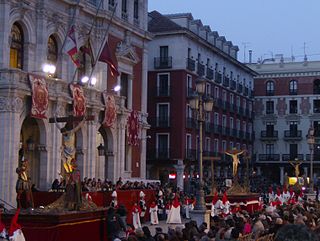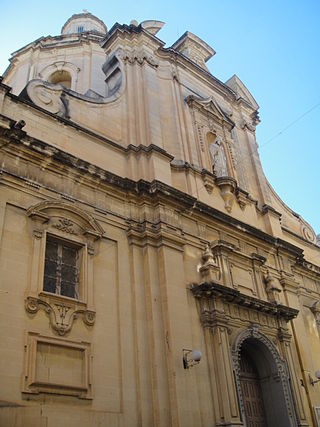
Easter, also called Pascha or Resurrection Sunday, is a Christian festival and cultural holiday commemorating the resurrection of Jesus from the dead, described in the New Testament as having occurred on the third day of his burial following his crucifixion by the Romans at Calvary c. 30 AD. It is the culmination of the Passion of Jesus Christ, preceded by Lent, a 40-day period of fasting, prayer, and penance.

Palm Sunday is the Christian moveable feast that falls on the Sunday before Easter. The feast commemorates Christ's triumphal entry into Jerusalem, an event mentioned in each of the four canonical Gospels. Its name originates from the palm branches waved by the crowd to greet and honor Jesus as he entered the city. Palm Sunday marks the first day of Holy Week; in Western Christianity, this is the beginning of the last week of the solemn season of Lent, preceding Eastertide, while in Eastern Christianity, Holy Week commences after the conclusion of Great Lent.

Valletta is an administrative unit and the capital of Malta. Located on the main island, between Marsamxett Harbour to the west and the Grand Harbour to the east, its population within administrative limits in 2014 was 6,444. According to the data from 2020 by Eurostat, the Functional Urban Area and metropolitan region covered the whole island and has a population of 480,134. Valletta is the southernmost capital of Europe, and at just 0.61 square kilometres (0.24 sq mi), it is the European Union's smallest capital city.

Holy Week is the most sacred week in the liturgical year in Christianity. For all Christian traditions it is a moveable observance. In Eastern Christianity, which also calls it Great Week, it is the week following Great Lent and Lazarus Saturday, starting on the evening of Palm Sunday and concluding on the evening of Great Saturday. In Western Christianity, Holy Week is the sixth and last week of Lent, beginning with Palm Sunday and concluding on Holy Saturday.

The culture of Malta has been influenced by various societies that have come into contact with the Maltese Islands throughout the centuries, including neighbouring Mediterranean cultures, and the cultures of the nations that ruled Malta for long periods of time prior to its independence in 1964.

Siġġiewi, also called by its title Città Ferdinand, is a city and a local council in the Southern Region of Malta. It is the third largest council in Malta by surface area, after Rabat and Mellieħa. Siġġiewi is situated on a plateau a few kilometers away from Mdina and 10 kilometres away from Valletta, the contemporary capital. It is the home of 8,721 inhabitants as of January 2019. Until several decades ago, almost all of the population was employed in the fields which surround the city. In 1993, the city adopted the motto Labore et Virtute.

The Feast of the Ascension of Jesus Christ commemorates the Christian belief of the bodily Ascension of Jesus into Heaven. It is one of the ecumenical feasts of Christian churches, ranking with the feasts of the Passion and Pentecost. Following the account of Acts 1:3 that the risen Jesus appeared for 40 days prior to his Ascension, Ascension Day is traditionally celebrated on a Thursday, the fortieth day of Easter, although some Christian denominations have moved the observance to the following Sunday, sometimes called Ascension Sunday. The day of observance varies by ecclesiastical province in many Christian denominations, as with Methodists and Catholics, for example.

A Holy Week procession is a public ritual march of clergy and penitents which takes place during Holy Week in Christian countries, especially those with a Catholic culture. Various images of the saints, especially the Virgin Mary, and most importantly the image of the crucified Christ are carried aloft by foot on shoulder-borne pasos as an act of penance; acts of mortification are carried out; traditional Christian hymns and chants are sung. In many confraternities of penitents, the faces of the members are covered by elaborate hoods, such as the capirote, as a way of hiding one's identity in order to not ostentatiously draw attention to oneself while performing penance. Crosses, and biers holding Catholic holy images surrounded with flowers and offerings of candles, are carried usually from one parish church to another led by the clergy, monastic orders, or heads of the penitential orders.

Għaxaq is a village in the Southern Region of Malta, with a population of 5,538 as of November 2021. The surrounding area is predominantly used for agriculture.

Catholic Christianity is the predominant religion in Malta. The Constitution of Malta establishes Catholicism as the state religion, and it is also reflected in various elements of Maltese culture.
Easter is one of the most significant events in the religious and social calendar, celebrated heavily in the European country of Malta.

Maltese architecture has its origins in prehistory, and some of the oldest free-standing structures on Earth – a series of megalithic temples – can be found on Malta. The islands were colonized by the Phoenicians and later the Romans, who established the cities of Melite and Gaulos. Although these were substantial settlements and are known to have had numerous temples, churches and palaces, few remains have survived apart from some architectural fragments.

St. George's Basilica or the Basilica and Collegiate Parish Church of Saint George, also simply known as San Ġorġ in Maltese, is a historic Baroque church situated in the middle of Gozo, the second largest island in the Maltese archipelago, and is surrounded by a maze of old narrow streets and alleys. Today's basilica was built between 1672 and 1678.

In the small Mediterranean island nation of Malta the predominant religion is Roman Catholicism.

The Collegiate church of Saint Lawrence is an old Church situated in Birgu in Malta.
The Holy Week in Braga is the most imposing, attractive and famous among all in Portugal, and the most important tourist and religious event in the city of Braga. It is estimated that about 100.000 people attend the major processions. It combines harmoniously elements of the liturgy and of popular piety, ancient traditions and innovation. Since November 2011, this event is officially “Declared of Interest to Tourism”.

The Holy Week in Valladolid is one of the main tourist attractions, and cultural and religious events of Valladolid and the surrounding province during Holy Week in Spain. It boasts of renowned polychrome sculptures, created mainly by sculptors such as Juan de Juni and Gregorio Fernández, who were active when the city served as the imperial court. The city's National Sculpture Museum has a total of 42 images for the processions. The Holy Week in Valladolid is known to depict the Passion with great fidelity, rigor and detail.

The Church of Saint Nicholas, also known as the Church of All Souls, is a Greek Catholic church in Valletta, Malta, dedicated to Saint Nicholas. Originally built as a Greek Orthodox church in 1569, it was conceded to the Confraternity of the Souls in Purgatory in 1639, who rebuilt the church in the Baroque style in 1652. The church was passed back to the Greek Catholic congregation in 2014 however the church is used from Ecumenical Patriarchate of Constantinople.

The Church of St Francis is a Roman Catholic church building in Victoria, Gozo, Malta, situated in St Francis Square. Adjacent to the church is the convent of the Conventual Franciscans.

St. Catherine's Old Church, also known as St. Gregory's Church, is a Roman Catholic church in Żejtun. The church and its complex sit towards the outskirts of the town, commanding views over Marsascala Bay, St. Thomas' Bay and Marsaxlokk harbour. The church is colloquially known as Saint Gregory's due to a traditional procession held on the first Wednesday following Easter Sunday. Its dedication to Catherine of Alexandria dates back to an original chapel on this site, which was one of the eight mother churches on Malta. The church stands next to the three cemeteries of Żejtun, dedicated to St. Rocco, St. Gregory and St. Catherine. The church's functions as the parish church of Żejtun were taken over by a new parish church, also dedicated to St. Catherine, and designed by Lorenzo Gafà.

















